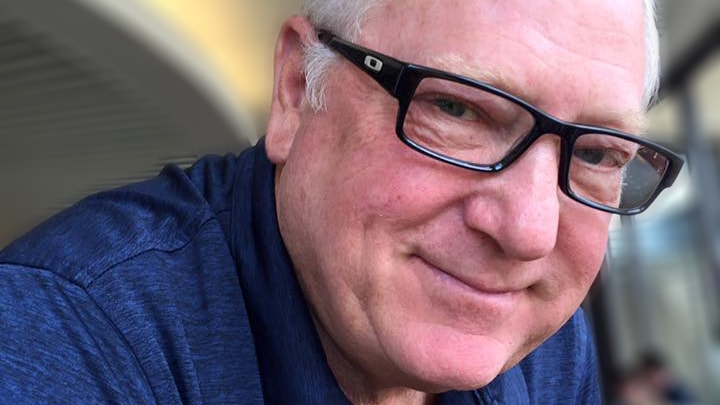Prostate Cancer Patient Documents His Treatment

Using photography, one man chronicles his journey to beat cancer.
Faced with 42 days of radiation therapy to treat his prostate cancer, Rodney Dan Marolf decided on the very first visit to make the daunting process a little more personal.
At his first radiation session this summer, the 67-year-old fit his body into a precise mold custom made to target his tumor and waited for the care team at the University of Michigan Rogel Cancer Center to ensure the radiation beam was correctly aligned with tattoo markers they’d made on his back.
The 20-minute treatment, Marolf recalls, was painless.
Despite anxiety and the unfamiliar surroundings, he emerged hopeful -- expressing that sentiment to his spouse, Cathy, who accompanied him to U-M from their home in Lansing, about an hour’s drive away.
“I remember coming out to my wife in the waiting room. I put up one finger to show, there’s one treatment,” Marolf says. “She took my picture.
“I said: ‘You know, I’m going to do this every day.’”
And they did, finding a new and creative way to photograph Marolf at each subsequent treatment with the corresponding number.
They made it fun, distracting from the reality that he was being treated for cancer and the weight of logistical issues such as constant travel and a desire to continue working.
Beyond its role as a timekeeper, the photo project offered therapeutic power.
“Like all journeys in life, attitude has a large part on how you enjoy and perceive the journey and end result,” says Daniel Spratt, M.D., formerly chief of the genitourinary radiation oncology program at the U-M Rogel Cancer Center. “Rod’s positive attitude, I believe, helped him go through treatment seamlessly, enjoy life during the process, make good friends and lasting impressions.”
Coming into focus
Like many others facing illness, Marolf had a hard time believing the prostate cancer diagnosis belonged to him.
He had experienced some minor urinary issues in the past, but nothing serious. When an elevated PSA test led to a biopsy that came back positive, he and his adult daughters began to research the best places for treatment. Marolf was even willing to relocate if necessary.
After learning about programs in California and other areas of the country, he called the American Cancer Society for help.
“I asked them for the No. 1 place in the country for this kind of cancer,” Marolf says. “They asked if I had ever heard of Ann Arbor.”
Relieved to be referred to a place so close to home, Marolf immediately felt confident with the attitude and support of Spratt and Peter Hawkins, M.D. He also praised the team’s complete focus on precision when it came to his treatments.
“If I had a gas bubble, they’d make me walk around and check me until it was gone,” Marolf says. “I loved the precision they insisted upon when they lined me up on the machine. The staff was that particular in making sure every aspect of my treatment procedure was the best it could possibly be.”
Progress in the delivery of advanced radiotherapy techniques has allowed for precise targeting of cancer while avoiding unnecessary high doses of treatment to nearby healthy organs, Spratt says. In the case of prostate cancer, the organ is close to the bladder, rectum and structures that control sexual function.
“For this reason, we need to make sure that every single treatment we deliver is delivered perfectly to maximize tumor kill and minimize any potential side effects,” Spratt says.
Setting the scene
Marolf began experiencing some side effects, mostly urinary discomfort and fatigue, after about 15 treatments. He took medication as prescribed to manage the side effects and lessen discomfort.
It didn’t hinder his photographic mission -- a project that was well underway and by that point a welcome diversion.
Still, creativity was key in finding new ways to document Marolf’s countdown.
The radiation oncology staff got involved in helping him locate new places to take photos. On Aug. 15, 2016, the Marolfs brought cupcakes and party hats to treatment to celebrate Rod’s birthday.
The couple also scoured the Michigan Medicine facilities and adjacent college campus for ideas. They even took steps to get photos in the Crisler Arena, home to U-M men’s basketball, and Michigan Stadium, where the Wolverines play football.
The Marolfs, meanwhile, played a trick on Rod’s care team by creating humorous mock tattoo messages on his back for some of his treatments.
Says Spratt: “It made me smile every day I saw him and he would pull out his cellphone and show me, ‘Dr. Spratt, look what I did for treatment 21.’ It also helped Rod cheer other patients up and help them with what they were going through.”
The unlikely portrait subject is now looking to the future.
With his 42 treatments complete, Marolf will return in three months for blood tests to determine whether his PSA level has gone down.
But the collection of photographs -- and the circumstances that inspired them -- remain fresh in his mind.
“Right from the beginning, I thought this whole thing is going to be a challenge,” Marolf says. “I wanted to distract myself from the cancer struggle and apply it to the challenge of getting photos. It was fun and exciting to see the attitude of the staff and the caring support. It distracted me as the patient and they got to do something a little different, too.”
